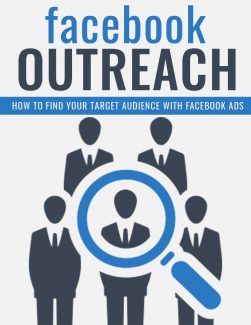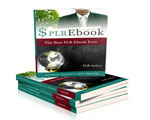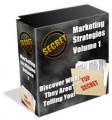 License Type: Private Label Rights
License Type: Private Label Rights  File Type: ZIP
File Type: ZIP
 SKU: 61956
SKU: 61956  Shipping: Online Download
Shipping: Online Download
Sample Content Preview
Introduction
Unless you’ve been living under a rock for the last decade or so, you already know how huge Facebook is. They claim to have over 1 billion daily active users, and many of those people spend close to an hour a day using the site, on average.
The biggest problem with Facebook in recent years is that their organic reach—the people you can reach without spending money—has declined to nearly zero. Even if you have a fan page with thousands of fans, you still have to pay to reach your own fans. Crazy, right?
It’s not all that crazy if you think about it. Most people are fans of dozens, if not hundreds of pages on Facebook. If all those pages shared several articles per day, most of the posts would just get lost, anyway. There’s just too much content being posted.
So, Facebook has implemented some changes that make it so that only a small fraction of a page’s users ever see each post.
We all know this wasn’t done solely to keep Facebook’s users happy. It’s pushed a lot of people to spend money on ads, despite having a huge following on the site. It’s a wonder they don’t have a mutiny on their hands! But since they’re such a huge source of traffic, we all do what we have to do, which is paying for ads even if we already have thousands of fans.
Yes, it sucks for those of us who paid for advertising to obtain those fans in the first place, because we then have to pay again to have our posts reach those fans we already paid for. It’s double-dipping at its finest. But if you wanna play, you gotta pay. And it’s their site, so it’s their rules.
In this guide, you’re going to learn how to basically beat Facebook at its own game by learning how to create ads that will get both paid and organic reach, as well as how to get the most bang for your buck by learning how to create widely successful ads at the lowest prices possible.
We’ll also cover the best ways to target the right audience for maximum profitability, how to keep your costs down, and how to use retargeting to pull in potential lost sales.
So, let’s get started!
Getting Started
The first thing you need to do is log into your Facebook account, or create one if you don’t already have one. You can use your personal Facebook account for this if you want, because your ads are in no way linked to your name. They’d be linked to your Facebook fan page, if anything.
It’s highly recommended that you do all your work with Facebook Ads on a desktop computer or laptop, not on a mobile device. If you don’t have a desktop or laptop, see if you can borrow one, or use one at a library or internet café. The dashboard is buggy at times on mobile.
To get to your dashboard, click the small arrow at the top right of your Facebook profile to bring up the drop-down menu and click on “Manage Ads”.
You can also just type in the URL if you can’t find this option easily:
>> http://www.facebook.com/ads
If you’re using an ad blocker, they’ll ask you to turn it off or add the web page to your exception list. Once this is done, you should refresh the page.
You may find this dashboard a little confusing at first. There are a lot of available options, and sometimes they can seem a little redundant. The same information may appear in multiple locations. Take a little time to familiarize yourself with the dashboard before jumping into ad creation.
You’ll notice there’s a Guided Creation mode that will help guide you through the process and a Quick Creation mode for people who are a little more familiar with the Facebook Ads creation process.
Once you’ve got a hang of the basic options, let’s take a close look at the different types of ads that are currently available.
Guided Creation
If you’re new to Facebook Ads, you might want to try out their Guided Creation mode.
In this mode, you’ll have three different categories of options (Awareness, Consideration, and Conversion) and multiple selections within each category.
Under Awareness, you will see Brand awareness and Reach. Brand awareness is basically when you want to target people as tightly as possible for the best conversion rates, and Reach is when you want to get as many views or visitors as possible.
Most of the time, Brand awareness is the better option, because most businesses want to focus tightly on their niche.
Under Consideration, you will see six different options:
Traffic, Engagement, App installs, Video views, Lead generation and Messages.
Traffic is used to drive traffic to a particular destination. Engagement is to help increase elements such as likes and shares of your content on Facebook. App installs will help you get more people to install your app. Video views will get more people to view your video content. Lead generation will help you build your list, and Messages will help you get more direct messages sent to your Facebook page.
Under Conversion, there are three options:
Conversions, Catalog sales, and store visits.
Conversions will help you get various types of actions on your website or app, such as opting in to your email list, signing up for a membership, or watching a view. Catalog sales will display various products from your online store to increase sales. And Store visits will drive foot traffic to a brick-and-mortar location.
Confused, yet? Don’t worry, I’ve got your back.
Let’s say you have an online store selling pet supplies. You want to get more people to buy your products, so you would choose “Catalog sales”. This will allow you to add items from your online store to a catalog of merchandise that let you make different types of ads that focus on selling specific items.
In order to use this type of ad, you’ll need to set up your catalog. There are four types of catalogs you can create: E-commerce, Travel, Real Estate, and Auto. The other three categories are self-explanatory, and the E-commerce category covers anything that doesn’t fit into those three (anything sold online.)
If you’re using Shopify, WooCommerce, BigCommerce, Magento, or Google to sell your products, they have a process that will help you import your entire product catalog quickly. If you’re using the E-commerce category for your catalog, you can save a lot of time with this method.
Each selection has a specific purpose, so you can choose the one that’s right for your goals.
Once you’ve decided which type of campaign you’d like to run, it’s time to start targeting your audience.
Ad Types
Once you get used to creating Facebook Ads, you might switch over to manual creation. This will make everything a little easier to customize, but it can be a bit daunting for new marketers.
There are many different types of ads, but almost all of them will require some sort of image or video. Right now, we’re going to cover three different types of ads that you’re most likely to create right now.
Link click ads are the most popular type of ad. They can send people to your website, blog, landing page, squeeze page, etc. These ads can be placed in the right column, desktop newsfeed, mobile newsfeed, audience network, or on Instagram.
The recommended size is 1,200 x 628 pixels, 90 characters of ad copy, a 25-character headline, and 30 characters for the description.
Video ads are also very popular on Facebook. These can only be placed on the desktop newsfeed, mobile newsfeed, audience network and on Instagram.
Videos should be in either 16:9 or 9:16 ratio, up to 4 GB in file size, and no longer than 120 minutes in length. (The best performing videos are 15-30 seconds.) Your ad copy can be up to 90 characters.
Boosted page posts will help you get more views, likes, comments, and shares of posts on your Facebook page.
You can target your own Facebook page audience, or others based on your targeting. They can appear on the desktop newsfeed, mobile newsfeed, audience network and Instagram.







